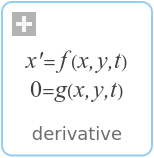WOLFRAM SYSTEM MODELER
derivativederivative |
|
Wolfram Language
SystemModel["ModelicaReference.Annotations.derivative"]

Information
This information is part of the Modelica Standard Library maintained by the Modelica Association.
Define derivative of function
Examples
function foo0 annotation(derivative=foo1); end foo0; function foo1 annotation(derivative(order=2)=foo2); end foo1; function foo2 end foo2;
Description
Derivatives of functions can be declared explicitly using the derivative annotation, whereas a function can be defined as a partial derivative of another function using the der-operator in a short function definition.
A function declaration can have an annotation derivative specifying the derivative function. This can influence simulation time and accuracy and can be applied to both functions written in Modelica and to external functions. A derivative annotation can state that it is only valid under certain restrictions on the input arguments. These restrictions are defined using the following optional attributes: order (only a restriction if order > 1, the default for order is 1), noDerivative, and zeroDerivative. The given derivative-function can only be used to compute the derivative of a function call if these restrictions are satisfied. There may be multiple restrictions on the derivative, in which case they must all be satisfied. The restrictions also imply that some derivatives of some inputs are excluded from the call of the derivative (since they are not necessary). A function may supply multiple derivative functions subject to different restrictions.
The inputs to the derivative function of order 1 are constructed as follows:
- First are all inputs to the original function, and after all them we will
in order append one derivative for each input containing reals.
- The outputs are constructed by starting with an empty list and then in
order appending one derivative for each output containing reals.
- If the Modelica function call is a nth derivative (n>=1), i.e., this
function call has been derived from an (n-1)th derivative, an
annotation(order=n+1)=?, specifies the (n+1)th derivative, and the
(n+1)th derivative call is constructed as follows:
- The input arguments are appended with the (n+1)th derivative,
which are constructed in order from the nth order derivatives.
- The output arguments are similar to the output argument for the nth derivative, but each output is one higher in derivative order.
Example: Given the declarations
function foo0 ... input Real x; input Boolean linear; input ...; output Real y; ... annotation(derivative=foo1); end foo0; function foo1 ... input Real x; input Boolean linear; input ...; input Real der_x; ... output Real der_y; ... annotation(derivative(order=2)=foo2); end foo1; function foo2 ... input Real x; input Boolean linear; input ...; input Real der_x; ...; input Real der_2_x; ... output Real der_2_y; ...
the equation
(...,y(t),...)=foo0(...,x(t),b,...);
implies that:
(...,d y(t)/dt,...)=foo1(...,x(t),b,..., ...,d x(t)/dt,...); (...,d^2 y(t)/dt^2,...)=foo2(...,x(t),b,...,d x(t)/dt,..., ...,d^2 x(t)/dt^2,...);
An input or output to the function may be any simple type (Real, Boolean, Integer, String and enumeration types) or a record, provided the record does not contain both reals and non-reals predefined types. The function must have at least one input containing reals. The output list of the derivative function may not be empty.
- zeroDerivative=input_var1
The derivative function is only valid if input_var1 is independent of the variables the function call is differentiated with respect to (i.e., that the derivative of input_var1 is "zero"). The derivative of input_var1 is excluded from the argument list of the derivative-function. Assume that function f takes a matrix and a scalar. Since the matrix argument is usually a parameter expression it is then useful to define the function as follows (the additional derivative = f_general_der is optional and can be used when the derivative of the matrix is non-zero).function f "Simple table lookup" input Real x; input Real y[:, 2]; output Real z; annotation(derivative(zeroDerivative=y) = f_der, derivative=f_general_der); algorithm ... end f; function f_der "Derivative of simple table lookup" input Real x; input Real y[:, 2]; input Real x_der; output Real z_der; algorithm ... end f_der; function f_general_der "Derivative of table lookup taking into account varying tables" input Real x; input Real y[:, 2]; input Real x_der; input Real y_der[:, 2]; output Real z_der; algorithm ... end f_general_der; - noDerivative(input_var2 = f(input_var1, ...) )
The derivative function is only valid if the input argument input_var2 is computed as f(input_var1, ...). The derivative of input_var2 is excluded from the argument list of the derivative-function. Assume that function fg is defined as a composition f(x, g(x)). When differentiating f it is useful to give the derivative under the assumption that the second argument is defined in this way:
This is useful if g represents the major computational effort of fg).function fg input Real x; output Real z; algorithm z := f(x, g(x)); end fg; function f input Real x; input Real y; output Real z; annotation(derivative(noDerivative(y = g(x))) = f_der); algorithm ... end f; function f_der input Real x; input Real x_der; input Real y; output Real z_der; algorithm ... end f_der;
